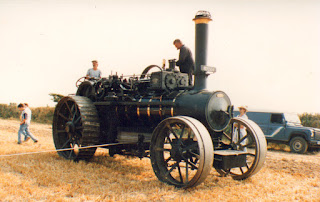 |
| Bereaved twin Hero in between pulls of the plough |
My mother was a twin to my Auntie Margaret. They might have been identical twins although I could always tell them apart.
They identified with ploughing engines built in pairs. One was built to winch from the left and the other winched from the right. With a friendly amount of whistling between the two, they would shuffle forward gradually along the field, speeding the plough between them.
 |
| Hero pulls from the right hand side with its secondhand Fowler cable drum |
Ploughing was heavy work so the boilers were big and the cylinders of the engine equally massive. Their wheels were wider than other engines to spread their weight over soft ground. Overall, ploughing engines had a greater physical presence compared to other traction engines.
My mother and aunt often said it was the plainness of these huge engines appealed. I don't think they personally identified with that plainness. It was the twinship they liked and the massive gentle power of these unadorned locomotives. They felt that the showman's engines, which had a different presence on the showground, were too much like peacocks with their lights, gleaming brass and gaudy paintwork.
Ploughing engines were big and unpretentious but with a massive, silent strength - a bit like my dad I suppose...
 |
| Hero works hard to draw the plough |
Above all ploughing engines, Hero was their favourite. Hero had lost its twin and denuded of its cable drum. Fortunately, the Daniel brothers in Bodmin teamed it up with another solitary ploughing engine, a smiley-faced Fowler. With a cable drum from another Fowler, the mismatched pair gave many demonstrations of steam ploughing over the years.
Fowlers are much more common and have such friendly faces in their smokebox doors. Reverend Awdry would be sure to approve. Usually black, ploughing engines have the minimum of brasswork but Hero was even plainer than the plainest Fowler. This lack of decoration adds to Hero's appeal.
 |
| This is Hero's new twin. It's a Fowler BB1 type, works no. 15163 of 1918, and has a different shape to the cylinder clock on the boiler. It also pulls from the lefthand flywheel side and is also rated at 16nhp. |
We could always spot Hero from a distance because the cylinder blocks on McLaren locomotives are obviously different from those of contemporary Fowlers.
Hero was built in 1919 with the works number of 1552. Its twin would have been 1553. Rated at 16nhp, it's a compound engine with two cylinders.
As far as I can make out, Hero was saved from being broken up by soil sterilising duties. The decision to save one and scrap the other seems quite arbitrary. They only needed one so... eeny, meeny, miney mo, OUT spells out. 1553 went for scrap.
 |
| Stance works - look at those wide wheels on this McLaren.... |
Another McLaren ploughing exists but this engine, also half of another pair, is smaller than Hero and rated at 12 nhp. That's too much of a size difference to work properly with our Hero.
The 16 nhp Fowler BB1 ploughing engine that's now teamed up with Hero, at times unofficially known as Headland Beauty, is works number 151563 of 1918. Its twin, 15162, did not make it into preservation.
It still strikes me as strange, though.
Why scrap one and not the other?
 |
| Hero at the 2019 Great Dorset Steam Fair |









Comments
Post a Comment